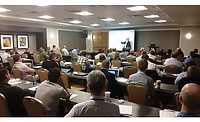ASI interviews a distribution exec to answer an age-old question.

Comstock Park, MI-based L&D Adhesives Inc. has been an adhesive distributor since 1972. L&D represents 30 different adhesive manufacturers, from big players like 3M, Henkel and Bostik to niche companies like Adhesive Systems and American Sealants. The company boasts a customer base of 700 end users ranging from office furniture giants Herman Miller, Steelcase and Haworth to boat manufacturers like S2 Yachts. L&D’s sister division, ServCorp Inc., is a 3M wholesaler that sells exclusively to other distributors. ServCorp is also a certified government contractor selling to the GSA.
ASI recently spoke with L&D Adhesives’ Vice President Sue Joslin to get a better understanding of the role of the distributor in the adhesives and sealants industry, as well as to discuss her company’s approach to business in an ever-changing market.
ASI: Could you please give us a brief description of what a distributor does?
Joslin: A distributor buys large quantities of adhesives, tape, sealants and abrasives from manufacturers and stores them in a warehouse for its customers. At L&D, we try to anticipate our customers’ needs based on past volumes in order to reduce lead times to obtain product. We have our own truck that delivers products from our warehouse to companies around West Michigan, though we use LTL Carriers or UPS for shipments as well.
L&D also provides assistance to its manufacturing partners and makes recommendations on products from the prototyping stage through actual production. We have sales and technical personnel within our company - in addition to those of the manufacturer - to help our customers with any questions that may arise.
ASI: What is the most common misconception about distribution?
Joslin: People assume that going through distribution will cost them more money. This is not true if you compare apples to apples. Most manufacturers have minimum order quantities that are way too high for end users - and they continue to increase these amounts. The lead time from the manufacturer is also on the rise. Most end users want just-in-time delivery and will not consider storing any extra product in their own inventory. For us to juggle products, lead times and delivery schedules shifts this burden away from our customers, thus saving them time and money.
ASI: What makes L&D Adhesives unique in the adhesives distribution market?
Joslin: Two things: One, we are a one-stop local shop for 30+ adhesive companies. Most customers use several types of adhesives, sealants, MRO products and abrasives. They love the fact that they can make one local phone call to order several different items. They can consolidate their vendor lists, which also saves them the costs of maintaining large numbers of vendors. Our customers know, too, that they will always speak to a real person here, vs. getting lost in myriad voicemail options.
Two, we make “housecalls.” In addition to our inside sales staff that handles many questions via phone and e-mail, our outside salespeople visit customers on-site to help them find the best solutions for their bonding applications.
ASI: L&D has worked as a 3M wholesaler for over 30 years. What has made your business relationship so successful?
Joslin: 3M is so distributor-oriented in their marketing, thinking and innovation that they make you (as a distributor) feel like a very important, integral part of their team. They are willing to help with whatever their partners need.
ASI: Are there manufacturers who don't get the manufacturer/distributor dynamic?
Joslin: There are certain manufacturers who have a very good understanding of what it is that a distributor does. Obviously, 3M is one of them. 3M sells pretty exclusively through distribution only, so their mindset, as it concerns the manufacturer/distributor dynamic, is one of a very close partnership. They make all of their technical support available to their distributors; all of their sales force is available. They look at us as another branch of salespeople that is out there in the field working with them.
Then you have other manufacturers who do not understand distribution or make any attempt to function within that manufacturer/distributor dynamic. For example, they’ll have a sales team out in the field and they’ll also have distributors. Their sales people look at their distributors as direct competition as opposed to working as part of the same unit. I think a lot of that animosity comes from the structure that is set up within that particular manufacturer - who gets compensated for what.

ASI: What are the biggest challenges your company faces?
Joslin: Over the past few years there have been so many issues with raw materials that price increases have been outrageous. We’ve seen this happen more in the past three years than we did in the previous 20 years combined. Also, if I hear the word (Hurricane)‘Katrina’ one more time I’m just going to scream. That was a big excuse for price increases for the longest time - ‘Katrina, Katrina.’ Enough is enough. So, it’s frustrating. But my husband (L&D president) Bob’s theory is that the manufacturers’ mantra these days is ‘Buy more, pay more and wait longer to get it,’ because that’s how they seem to be operating these days.
Actually, my biggest daily challenge is probably transportation. Because some of the materials we deal with have been designated ‘hazardous,’ we have to make sure we’re following every rule of hazardous shipping as outlined by the Department of Transportation. The rules that have been established for the shipping and transportation of hazardous products can be cumbersome.
ASI: How has the adhesives distribution business changed over the years?
Joslin: Manufacturers have taken to setting minimum-quantity purchase requirements for their distributors, and they’re raising that number constantly. So distributors have to order a set amount of product, and the price keeps going up. Also, a lot of companies are manufacturing to order these days, which is this just-in-time, we’re-not-stocking-too-much-excess-inventory-anymore thing, so a lot of what you order isn’t necessarily readily available. As you might imagine, this affects the services that my company, as a distributor, can provide to its customers, which affects my future planning much more.
Also, I think we’re seeing more conglomerates out there, which makes it more difficult to do business. Everybody buys and sells each other in this industry. One day you’re a distributor for three different companies, the next day they’re all under the same umbrella. It happens all the time, and by the time it’s over, you wind up right back where you started.
ASI: What are your feelings on ISO certification?
Joslin: I think the industry takes ISO far too seriously. Sure, it offers advantages to certain businesses in that it lets them look at internal systems that they’ve perhaps neglected, but you can do that on your own. Nobody has to tell you to do that, or force you to do that.
ASI: How do environmental regulations affect the way you do business?
Joslin: California and other states are really into low-VOC products nowadays, so we can’t ship certain things to California anymore if they have a high level of VOCs in them. We have to make sure everything that is shipped to California - or to any plant that’s going to be dealing with California - doesn’t have those products.
We also have to be qualified through an audit conducted by our state police department because we own a truck that carries hazardous materials. We must keep logs and records that meet the regulations of the transportation department. It’s just a matter of keeping those systems monitored to make sure you’re doing a good job. Then again, every time you think you’re doing something right, something goes wrong, and then they add another rule to your list that you have to get used to - that kind of thing. Basically, you just try to follow the rules as best you can and deal with the changes as they come.
ASI: Has technology had a positive or negative impact on the way you do business?
Joslin: Today’s technology has made it easy for me to do things online, like place orders, research products, etc., but if you were to ask my husband the same question he’d say, ‘I hate it because I can’t talk to anyone.’ And, to a certain degree, he’s right: business lacks personal communication these days because we’re all doing so much online. We’re sending e-mails or leaving voicemails. To me, that does nothing but delay solving an issue, placing an order - whatever it is you’re trying to do. It just slows everything down because now, instead of being proactive, everybody’s sitting back waiting for a response.
ASI: What are your plans for the future of L&D Adhesives?
Joslin: We continue to try and grow the business. My husband and I are getting closer to retirement age, so we’ll have to assess what action we want to take in the next few years. In the meantime, we are very grateful to have such loyal and trusting customers, and we value them very much. We strive to bring them the best products at a fair price, and to assist whenever we are needed.
For more information on L&D Adhesives, visit www.adhesives.com.
Links

